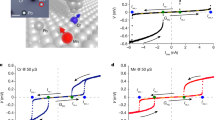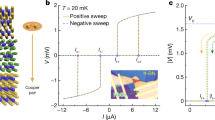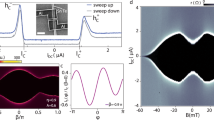Abstract
When two superconductors are connected by a weak link, a supercurrent flows, the magnitude of which is determined by the difference in the macroscopic quantum phases of the superconductors. This phenomenon was discovered by Josephson1 for the case of a weak link formed by a thin tunnel barrier: the supercurrent, I, is related to the phase difference, π, through the Josephson current–phase relation, I = Icsinπ, with Ic being the critical current which depends on the properties of the weak link. A similar relation holds for weak links consisting of a normal metal, a semiconductor or a constriction2. In all cases, the phase difference is zero when no supercurrent flows through the junction, and increases monotonically with increasing supercurrent until the critical current is reached. Here we use nanolithography techniques to fabricate a Josephson junction with a normal-metal weak link in which we have direct access to the microscopic current-carrying electronic states inside the link. We find that the fundamental Josephson relation can be changed from I = Icsinπ to I = Icsin(π + π)—that is, a π-junction—by controlling the energy distribution of the current-carrying states in the normal metal. This fundamental change in the way these Josephson junctions behave has potential implications for their use in superconducting electronics as well as in (quantum) logic circuits based on superconductors.
This is a preview of subscription content, access via your institution
Access options
Subscribe to this journal
Receive 51 print issues and online access
$199.00 per year
only $3.90 per issue
Buy this article
- Purchase on Springer Link
- Instant access to full article PDF
Prices may be subject to local taxes which are calculated during checkout



Similar content being viewed by others
References
Josephson, B. D. Possible new effects in superconducting tunneling. Phys. Lett. 1, 251–253 ( 1962).
Likharev, K. K. Superconducting weak links. Rev. Mod. Phys. 51, 101–169 (1979).
Kulik, I. O. Macroscopic quantization and the proximity effect in S-N-S junctions. Zh. Eksp. Teor. Fiz. 57, 1745–1750 (1969); Sov. Phys. JETP 30, 944–950 (1970).
Ishii, C. Josephson currents through junctions with normal metal barriers. Prog. Theor. Phys. 5, 1525–1547 (1972).
Bardeen, J. & Johnson, J. L. Josephson current flow in pure superconducting-normal-superconducting junctions. Phys. Rev. B 5, 72–78 (1972 ).
Van Wees, B. J., Lenssen, K.-M. H. & Harmans, C. J. P. M. Transmission formalism for supercurrent flow in multiprobe superconductor-semiconductor devices. Phys. Rev. B 44, 470–473 ( 1991).
Wendin, G. & Shumeiko, V. S. Giant Josephson current through a single bound state in a superconducting tunnel junction. Phys. Rev. B 53, R6006–R6009 ( 1996).
Chang, L.-F. & Bagwell, P. F. Control of Andreev level occupation in a Josephson junction by a normal metal probe. Phys. Rev. B 55, 12678–12690 (1997).
Volkov, A. F. New phenomena in Josephson SINIS junctions. Phys. Rev. Lett. 74, 4730–4733 (1995).
Volkov, A. F. & Takayamagi, H. Long range phase coherent effects in the transport properties of mesoscopic superconductor–normal-metal structures. Phys. Rev. B 56, 11184– 11194 (1997).
Wilhelm, F. K., Schön, G. & Zaikin, A. D. Mesoscopic superconducting-normal metal-superconducting transistor. Phys. Rev. Lett. 81, 1682– 1685 (1998).
Yip, S.-K. Energy resolved supercurrent between two superconductors. Phys. Rev. B 58, 5803–5807 ( 1998).
Morpurgo, A. F., Klapwijk, T. M. & van Wees, B. J. Hot electron tunable supercurrent. Appl. Phys. Lett. 72, 966–968 (1998).
Pothier, H., Guéron, S., Birge, N. O., Esteve, D. & Devoret, M. H. Energy distribution function of quasiparticles in mesoscopic wires. Phys. Rev. Lett. 79, 3490 –3493 (1997).
Pothier, H., Guéron, S., Birge, N. O., Estève, D. & Devoret, M. H. Energy distribution of electrons in an out-of-equilbrium metallic wire. Z. Phys. B 104, 178– 182 (1997).
Bulaevski, L. N., Kuzii, V. V. & Sobyanin, A. A. On possibility of spontaneous magnetic flux in a josephson junction containing magnetic impurities. Solid State Commun. 25, 1053–1057 ( 1978).
Mühge, Th. et al. Possible origin for oscillatory superconducting transition temperature in superconducting/ferromagnet multilayers. Phys. Rev. Lett. 77, 1857–1860 ( 1996).
van Harlingen, D. J. Phase-sensitive tests of the symmetry of the pairing state in high-temperature superconductors—evidence for d x 2 − y 2 symmetry. Rev. Mod. Phys. 67, 515–535 (1995).
Echternach, P. M., Ghershenson, M. E. & Bozler, M. H. Evidence of interference between electro-phonon and electron-impurity scattering on the conductivity of thin metal films. Phys. Rev. B 47, 13659–13663 (1993).
Wellstood, F. C., Urbina, C. & Clarke, J. Hot electron effects in metals. Phys. Rev. B 49, 5942–5955 ( 1994).
Wilhelm, F. K., Zaikin, A. D. & Schön, G. Supercurrent in a mesoscopic proximity wire. J. Low Temp. Phys. 106, 305–310 (1997).
Estève, D. et al. in Mesoscopic Electron Transport: NATO ASI series E, vol. 345 375–406 (eds Sohn, L. L. et al.) (Kluwer Academic, Dordrecht/Boston/London, (1997).
Van Wees, B. J. & Takayanagi, H. in Mesoscopic Electron Transport: NATO ASI series E, vol. 345, 469 –502 (eds Sohn, L. L. et al.) (Kluwer Academic, Dordrecht/Boston/London, (1997).
Acknowledgements
We thank F. K. Wilhelm for discussions. This work was supported by the Nederlandse Organisatie voor Wetenschappelijk Onderzoek (NWO) through the Stichting voor Fundamenteel Onderzoek der Materie (FOM).
Author information
Authors and Affiliations
Corresponding author
Rights and permissions
About this article
Cite this article
Baselmans, J., Morpurgo, A., van Wees, B. et al. Reversing the direction of the supercurrent in a controllable Josephson junction. Nature 397, 43–45 (1999). https://doi.org/10.1038/16204
Received:
Accepted:
Issue Date:
DOI: https://doi.org/10.1038/16204
This article is cited by
-
Graphene amplifier reaches the quantum limit
Nature Nanotechnology (2022)
-
On the origin of the controversial electrostatic field effect in superconductors
Nature Communications (2021)
-
Giant fractional Shapiro steps in anisotropic Josephson junction arrays
Communications Physics (2020)
-
Controlling spin supercurrents via nonequilibrium spin injection
Scientific Reports (2019)
-
Interplay between Josephson and Aharonov-Bohm effects in Andreev interferometers
Scientific Reports (2019)
Comments
By submitting a comment you agree to abide by our Terms and Community Guidelines. If you find something abusive or that does not comply with our terms or guidelines please flag it as inappropriate.



